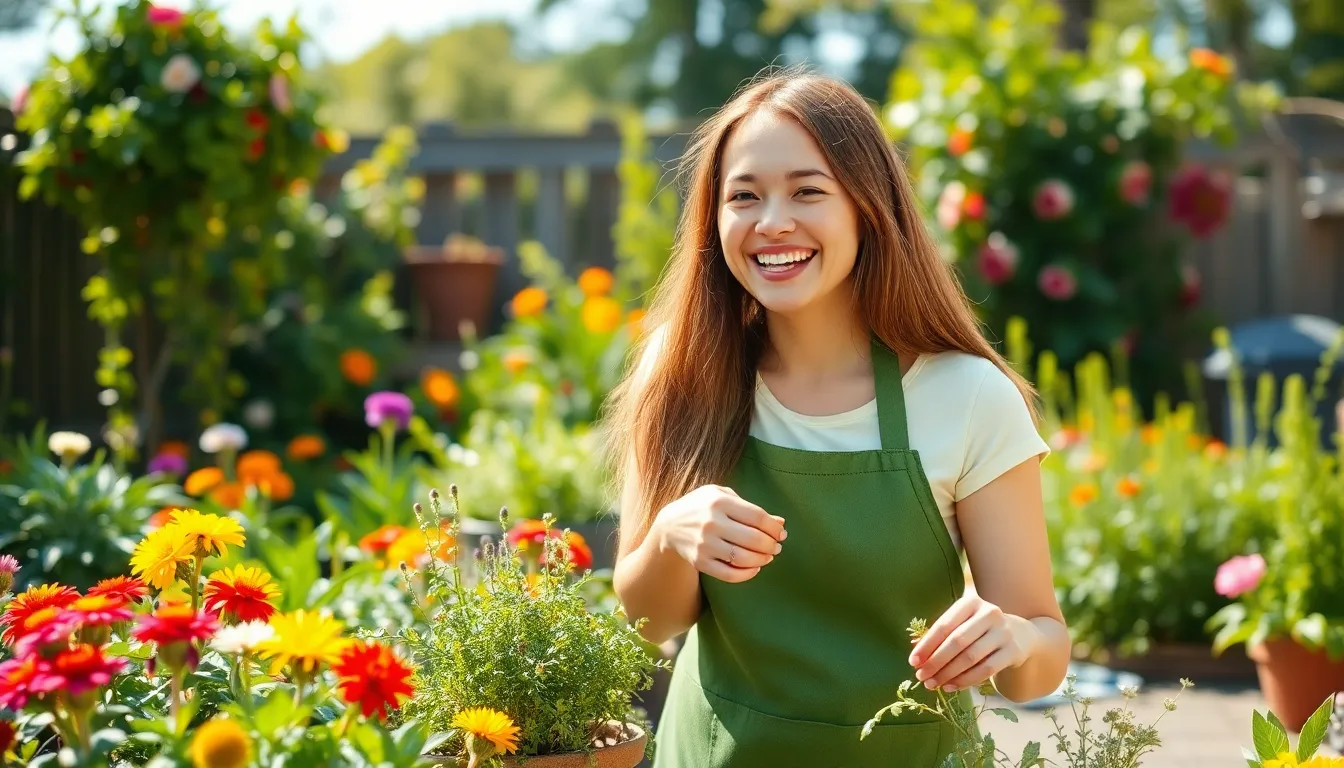Table of Contents
ToggleIn a world where plastic straws are the new villains and eco-anxiety is a common foe, it’s time to transform your home into a green sanctuary. Who said saving the planet had to be boring? With a sprinkle of creativity and a dash of humor, turning your abode into an eco-friendly haven can be as fun as binge-watching your favorite series on a Sunday afternoon.
Sustainable Living Overview
Sustainable living focuses on reducing one’s environmental footprint while enhancing quality of life. Embracing eco-friendly home practices leads to a healthier lifestyle and a more positive impact on the planet.
Incorporating energy-efficient appliances lowers electricity consumption significantly. Energy Star-rated devices use about 10 to 50 percent less energy than standard ones. Living spaces benefit from proper insulation, which retains heat in winter and keeps homes cool in summer, promoting year-round comfort.
Water conservation proves essential in sustainable homes. Installing low-flow fixtures, such as showerheads and faucets, can reduce water usage by 30 percent or more. Capturing rainwater provides an alternative source for irrigation, reducing reliance on municipal water systems.
Choosing sustainable materials is essential when renovating or furnishing homes. Products made from bamboo, reclaimed wood, and recycled metal contribute to sustainability. Selecting non-toxic paints and finishes ensures improved indoor air quality.
Waste management strategies, including recycling and composting, minimize landfill contributions. Approximately 30 percent of waste generated is compostable. Utilizing reusable containers and bags reduces single-use plastic dependency.
Gardening practices, such as organic gardening and permaculture, create biodiversity and enhance food security. Homegrown produce reduces the carbon footprint associated with food transportation while offering fresh options.
Socially responsible sourcing encourages ethical consumer habits. Supporting local businesses that prioritize eco-friendly products helps sustain local economies. Opting for second-hand items minimizes resource extraction and waste.
Overall, these sustainable practices not only protect the environment but also foster a sense of community and well-being. Each step taken towards sustainability contributes to a more resilient future for both individuals and the planet.
Energy Efficiency Tips
Improving energy efficiency transforms homes into sustainable spaces. Simple changes reduce energy consumption and lower utility bills.
Upgrading Insulation
Upgrading insulation enhances comfort while preventing heat loss. Foam board, spray foam, and blown-in cellulose represent effective materials. Properly insulated attics and walls sustain consistent indoor temperatures. The U.S. Department of Energy states that good insulation can save 10 to 50 percent on heating and cooling costs. Homeowners should consider sealing gaps around windows and doors to maximize insulation effectiveness. Choosing reflective materials also minimizes heat gain during warmer months.
Choosing Energy-Efficient Appliances
Choosing energy-efficient appliances lowers energy bills while benefiting the environment. Look for appliances with ENERGY STAR labels for guaranteed efficiency. A refrigerator using 40 percent less energy than older models significantly reduces consumption. Washing machines designed to use less water and energy enhance resource conservation. Using programmable thermostats allows more control over heating and cooling schedules. Overall, investing in modern appliances not only supports sustainability but also enhances daily living convenience.
Water Conservation Strategies
Water conservation plays a crucial role in creating an eco-friendly home. Implementing effective strategies can significantly reduce water waste and promote sustainability.
Low-Flow Fixtures
Low-flow fixtures are essential for minimizing water usage. These devices, including showerheads, faucets, and toilets, consume less water while maintaining performance. For example, low-flow showerheads use approximately 2.5 gallons per minute, compared to traditional models that can exceed 5 gallons. Installing these fixtures can lead to substantial reductions in water bills and conservation of resources.
Rainwater Harvesting
Rainwater harvesting captures rain for various household uses. By setting up a rain barrel or a more complex system, homeowners can collect rainwater from roofs. Rainwater can then be utilized for irrigation, flushing toilets, or even washing laundry. Collecting approximately 600 gallons of rainwater during a single storm can significantly lower reliance on municipal water supplies. This practice not only conserves water but also reduces stormwater runoff, positively impacting local ecosystems.
Eco-Friendly Materials for Home
Using sustainable materials in a home promotes environmental health and enhances indoor comfort. Homeowners can focus on options that reduce their overall ecological footprint.
Sustainable Flooring Options
Bamboo ranks as a popular choice for eco-friendly flooring due to its rapid growth and durability. Cork, harvested from the bark of cork oak trees, provides a renewable alternative that’s softer underfoot. Reclaimed hardwood offers character and history while minimizing waste in landfills. Linoleum, made from natural materials like linseed oil and jute, provides an environmentally friendly alternative to vinyl. Each option contributes to healthier indoor air quality and reduces the demand for new raw materials.
Non-Toxic Paint Choices
Opting for low-VOC or no-VOC paints significantly improves indoor air quality. Many brands now offer paints made from natural ingredients, reducing harmful chemicals released into homes. Milk paint, derived from milk protein, presents a non-toxic alternative with a unique finish. Mineral-based paints resist mold and mildew while providing a durable surface. Choosing non-toxic sealants and finishes also enhances the overall sustainability of a home.
Indoor Air Quality Improvements
Improving indoor air quality contributes significantly to a healthier living environment. Several strategies exist to enhance air quality in homes.
Houseplants for Clean Air
Houseplants serve as natural air purifiers. They absorb carbon dioxide and release oxygen, enriching indoor air. Certain types of plants, like snake plants and peace lilies, filter toxins such as formaldehyde and benzene. Adding these plants improves both air quality and aesthetic appeal. Studies show that maintaining just two plants per 100 square feet can significantly reduce indoor air pollutants. Care for these plants by ensuring proper light and watering for optimal health.
Natural Air Fresheners
Natural air fresheners offer a safe alternative to synthetic scents. Ingredients such as essential oils, vinegar, and baking soda combat odors without introducing harmful chemicals. By mixing essential oils with water in a spray bottle, one can create a refreshing room spray. Placing bowls of baking soda in various areas helps eliminate unwanted smells. Citrus peels steeped in water release pleasant fragrances while providing a non-toxic solution. Employing these methods enhances both ambiance and air quality throughout the home.
Transforming a home into an eco-friendly haven is more than just a trend; it’s a commitment to a sustainable future. By adopting these practices, individuals can significantly reduce their environmental impact while enjoying the process.
From energy-efficient appliances to sustainable materials and water conservation strategies, every small change contributes to a larger positive effect. Embracing eco-friendly habits not only enhances the quality of life but also nurtures a healthier planet.
As they embark on this journey, homeowners can take pride in making choices that benefit both their families and the environment. Sustainable living fosters a sense of community and well-being, paving the way for a resilient future.







